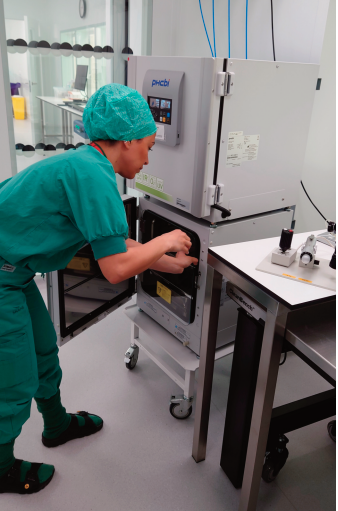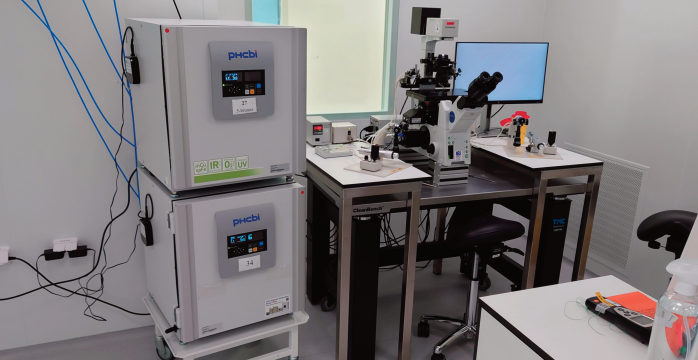The clinic started in 2007 with 15 staff and a small premises in the hospital area of Malmö. Over the years, the scope of IVF has expanded technically, and with new regulations introduced in Sweden that enable single women, homosexual, and transsexual couples, as well as heterosexual couples to seek IVF treatment. Now, the RMC clinic has more than 45 doctors, embryologists, nurses, midwifes and secretaries, who carries out approximately 28,000 patient meetings per year.
In terms of IVF (in vitro fertilization) treatments, RMC clinic is in second size to Sahlgrenska IVF clinic, Gothenburg.
“Our remit covers a lot of other treatments beyond IVF, and we have close reproductive research collaborations with Skåne University, but also other fertility clinics in Sweden and Denmark,” said Dr. Ingela Liljeqvist Soltic, Unit Manager of the Centre’s Laboratory. “We needed a bigger area and new facilities to match our expansion. After 7 years of searching for a proper building, able to support an IVF’s laboratory’s needs, as supply of gases and liquid nitrogen, plus easy to reach for our patients, the clinic was able to move in the Autumn of 2021 to a newly built facility that is three times bigger than our previous premises.”
Relocating and expanding an IVF clinic, like the reproductive medicine center, requires years of intricate consideration and planning because of the sensitivity of the biological samples that it works with. “
At the core of our work is providing the right environment for embryos and gametes,” Dr. Soltic explained. “Oocytes and embryos particularly are very sensitive to all fluctuations in the environment. So, it is vital to keep their environment in terms of temperature, pH, and gases stable. That was one of the main focus, when we were planning to build the clinic and the clean room. When you build an IVF lab, I believe everything must be built around the oocytes and embryos. Our focus is, of course, for adult patients, but also, we have our ‘small patients’ in the lab - the embryos.”
“Controlled conditions are essential in IVF, because the culture environment can have an impact on the new individual,” she continued. “The environment must be controlled and maintained at optimal every minute of every day, not only for the very start, but because inconsistencies in environment could affect the individual much later on – even several years later I talk about epigenetics, which means that external influences eg the environment of the embryos, will affect the genetics.”

"It’s important to get used to new equipment and fully understand how it works,” says Dr. Ingela Liljeqvist Soltic, Unit Manager of the Centre’s Laboratory “We have very good results with the PHCbi Incubators”
From the moment that an oocyte is collected from a patient, it needs to be placed immediately into a secure and optimal environment, at the right temperature. This must be maintained through the whole process of fertilization and development in the IVF lab, until it’s either transferred back to the uterus or vitrified. “The whole clean room and workflow is built around the oocyte and the logistics around how we handle them,” said Dr. Soltic. “When you make the laboratory larger, you have to think about in terms of managing the oocyte, for example minimizing its transport within the lab. It’s all about the environment.”
Intricate development process
RMC realised that more space was required many years ago, but the specific challenges of relocating an IVF clinic have led to a substantial process to find and develop a successful new facility.
“As we are a part of the Skånes University Hospital in Malmo, we wanted to be located close to the University Hospital, and close to the patients via trainand bus stations , easy for them to get to the clinic,” said Dr. Soltic. “On top of this, we still had to address technical challenges, such as our need to obtain and transport, liquid nitrogen frequently - every week and sometimes, twice a week. We also need delivery of large quantities of gas as carbon dioxide and nitrogen, to supply all incubators. The new clinic is build for the possibility to expand, the lab area and the amount of instruments, as eg incubators. Incubators, supporting each workstation, while processing gametes and embryos, but also for embryo culture up to 6 days.” Planning the interior of the empty property required a further two years.
"I read that PHCbi were using another conductor for the gas in their Incubators, which made them faster in getting back to the environment that I required. That was exactly what I was looking for as a functional working incubator.”
“We had to decide how to make the new site convenient and attractive to the patients, of course, but also for laboratory personal working in the cleanroom to achieve the best environment and situation for the oocytes and embryos,” said Dr. Soltic.
New incubation capacities
An important element of the planning was equipping the Centre with effective technology. Incubators are the artificial uterus and therefor important pieces of equipment. Oocytes and embryos require a specific temperature and conditions for survival and culture. The RMC clinic has invested in 11 of PHCbi’s newest and smallest (50L) Multigas Incubator, MCO-50M-PE. It also has older incubators from former PHC companies, Sanyo, and Panasonic. These were supplied via PHC Europe’s Swedish specialist IVF distributor, Vitrotech.
“When I started at the clinic, we had 50 litres Sanyo and Panasonic incubators,” remarked Dr. Soltic. “I believe they are robust incubators in terms of stability, but Vitrotech explained about some new PHCbi Multigas incubators.”

Every day in the lab, the challange to the Embryologist is to keep the environment of the culture conditions as stable as possible. One of the ideas, for the new lab, was to minimize fluctations in the environment for the embryos, by getting more work-incubators, to minimize any effect from door openings. “I read that PHCbi were using another conductor for the gas in their Incubators, which made them faster in getting back to the environment that I required. This convinced me to get them to the new IVF lab, as working incubators.”
“All instruments and devices in the IVF lab, taking care of the gametes and embryos, need to be monitored by an external meassure and alarm system. A smaller incubator chamber helps to maintain a stable environment and get a fast return to the desired environment after opening, but when you have an incubator with a smaller chamber, it’s not as easy to incorporate a system that constantly monitor the gas and the temperature,” she added. “The small, 50L PHCbi Multigas Incubators was easy to connect to the external alarm system RMC use, to monitor carbon dioxide gas concentration and the temperature.”
Service and support
Vitrotech arranged installation and even in getting the equipment connected to the gas supply.
“Everything was new in the facility. Even the gas supply needed to be established,” said Dr. Soltic. “Vitrotech have ensured that the PHCbi was in place.”
From October 2021 Dr. Soltic and her team worked with the new PHCbi incubators.
“It took a little time to get used to them. Even though we had a Panasonic before, the PHCbi has another display and commands. It’s important to get used to it to new equipment and fully understand how it works,” she said. “We have very good results with the PHCbi Incubators, they tend to be robust. It is also very important to have a close and good relationship with the Serv Tech. We are very dependent that the incubators are working properly and when not, we need to have fast support, by telephone or visit on site.”
“Based on the results of the new PHCbi incubators, I will consider to buy PHCbi to replace the older incubators, in the future. It has been a huge experience and challange, to build a new IVF clinic and to move the existing clinic, into the new facilities. It’s really good to be here and the future looks good.” added Dr. Soltic.
I have good contact with the Service Technician. He helps out both through the telephone, or in visiting here.It is also very important to have a close and reliable contact with the Serv Tech person.”